How Does Acupressure Work?
Electro-acupressure (Electro-acupuncture) allows you, without the use of needles, to stimulate points at which the energy flow is blocked by gently applying the tip of the instrument probe to the points that hurt. We call these “trigger points”, the Chinese call them “Ah-Shi” (practically translated “ouch”) points.
To assist with the location of Acupuncture points, Electro-acupressure units usually have a built-in detection facility with audio and visual read-outs. They should also provide a physical sensation, which will only be felt when 100% accuracy is achieved.
With the aid of sophisticated photographic technology, the points appear like electrical pores on the skin. If the point is viewed from the side, (in other words with the camera looking along the skin) a halo consisting of charged particles (called ions) can be seen. In some cases mostly negative ions and in other cases mainly positive. (see illustration)
Electro-acupressure technique can be as effective as traditional needle acupuncture. It will work in the vast majority of cases. On no account however should you insert acupuncture needles into yourself. Leave this to a qualified practitioner.
There are three currently favoured explanations. The Gate Control Theory of Pain, the Neuro-Endocrine Theory and the Semi-Conductor Theory.
The Gate Control Theory of Pain
Nerve fibres are like large bundles of various sized cables, some thick and some thin. The thin fibres transmit the sensation of pain, while the thick ones carry the sensation of touch. It has been found, by experiment, that if impulse transmission in the thick (touch) fibre is increased, conduction in the thin (pain) fibre is selectively blocked. This is by closing a gate, consisting of specific nerve cells, in the spinal cord. This provides a useful method of controlling pain. Anything that increases transmission in the touch fibres, such as rubbing an injured knee, will help relieve some of the pain. This theory relates more to the use of TENS machines, as they can use up to 3000 times more current than a 20 micro-amp stimulator. Acupuncture has been found to increase transmission in the thick (touch) fibres markedly. Electro-acupressure achieves the same result, to some extent, although the intensity of stimulation is low. It is nevertheless a significant factor, explaining some of the treatment success using Electro-acupressure.
Neuro-Endocrine Theory
One of the most recent and exciting discoveries in connection with acupuncture is the finding that needling an acupuncture point causes the body to release its own natural painkiller called endorphin (a protein molecule with very powerful pain killing capabilities). Endorphin is released by many parts of the nervous system and is related to the glandular or endocrine system, hence the term neuro-endocrine. It has been found that the release of endorphin is only a part of the explanation for some of the successes of Electro-acupressure.
Semi-Conductor Theory
An information and control system using direct current (DC) analogue electrical signals, which runs in connection with the nervous system, has been proposed by Robert Becker – a retired Professor of Orthopaedic Surgery working in New York State – to explain how acupuncture might work. His hypothesis is based on work with limb regeneration in amphibians and on the phenomenon of the current of injury. Becker’s hypothesis leads to a whole range of theoretical assumptions regarding acupuncture points.
Becker proposed that the signals in the DC system are carried via the neuroglia which are cells surrounding nerve fibres. Currents known to be produced by injury are said to be produced by this glial system, which is associated with growth and repair. For example, if an injury is created and there is no current of injury, then no growth or repair occurs.
Also electrical currents and associated fields have been shown to be fundamental to development in both plants and animals. Becker described a number of spectacular examples, including the regeneration of amputated limbs in newts, and finger-tips in children.
The integration of the glial system with acupuncture was proposed by Becker with acupuncture points acting like booster stations along the meridians, which are lines connecting acupuncture points, and these meridian lines act as transmission lines for these DC signals.
Acupuncture points along meridians do show specific electrical properties, and changes in these characteristics can be used for diagnosis. Acupuncture points appear to have little or no electrical activity when the tissue or organ which they represent is healthy.
When an injury takes place, or disease occurs, a current is produced local to that damage. At the same time, the properties of the related acupuncture point change, and there are also electrical changes in the acupuncture points in relationship to the surrounding skin. (see illustration below)
Acupuncture points are usually negative relative to the surrounding skin, with a value of -0.05 milli volts being fairly average. Higher negative values represent increased electrical activity in the corresponding anatomical area with readings of -0.25 milli volts. In acute conditions, this level can go up to as high as -0.75 milli volts. In extreme cases readings over -1 milli volts are usually associated with severe pain.
In other situations a high positive value is found, particularly with infections, psoriasis, asthma and allergies, and readings of +0.5 milli volts are not unusual. A low permanent positive value such as 0.001 milli volts is present in some chronic conditions such as in chronic osteoarthritis.
What this means is that it is possible to detect acupuncture points looking at voltage change. However, the most common method used to find acupuncture points is looking for areas of high conductance or low resistance (these both mean the same thing). This is what is used in the majority of Electro-acupressure instruments – a sensitive skin resistance meter being built-in to the unit.
The fact that semi-conductor properties are present in acupuncture points can be shown by taking the reading over an acupuncture point with a simple voltmeter. If the electrodes are reversed, and if ionic conduction was solely responsible, then the reading would remain the same but would have a negative to positive. In practice this rarely happens and the second measurement with the electrodes the other way round is often different. This indicates a partial, or in some cases total, semi-conductor effect.
What is found is that if a bi-polar electrical current is driven through a semi conductive tissue then normal conductive properties will be restored, the stored charge in the damaged area will be discharged and the resultant symptoms will disappear, often with sufficient treatment this can result in a complete disappearance of the problem.
In Conclusion…
Acupuncture points only become electrically active when a dysfunction is present in the body. The size and shapes of acupuncture points appear to vary considerably.
Electrical measurements reveal them in some cases to be zones within which a number of highly localized points may exist, and in other situations they appear to be highly localized points even localized within a small number of millimetres.
This simple biophysical model of acupuncture can be confirmed by any reasonably committed investigator, using a simple multi-meter. This confirms the semi-conductor properties of acupuncture points and their related tissue. It also provides a scientific basis for the use of a biphasic current of stimulation. Essentially what an acupuncture point is expressing when it becomes active (in other words where disease is present), is it is trying to resolve biophysically the electrical abnormality produced by the injury or disease in the affected tissue. The use of a biphasic current over the affected point facilitates this process, which in turn leads to a return to normal health. (see images 2, 3, & 4 above)
This theory, therefore, has the beauty of having considerable scientific evidence, and of its being able to be confirmed by simple experiments, which can be carried out by anybody of reasonable intelligence using a multimeter.
(Dr Julian Kenyon MD, Southampton, UK., February, 1995.)

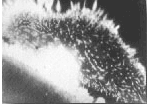
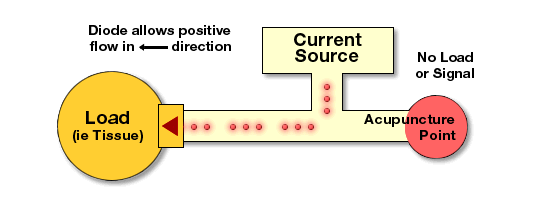
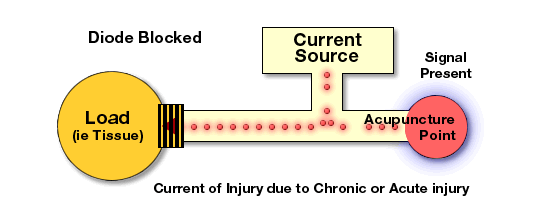
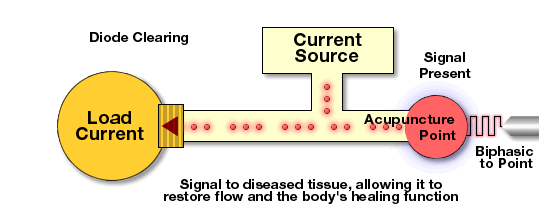
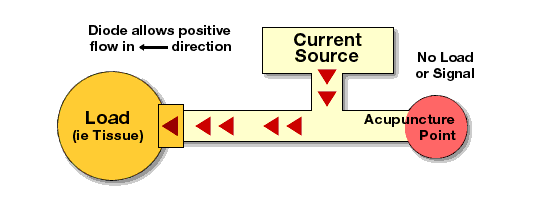
Recent Comments